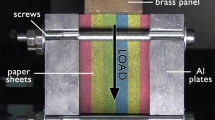Abstract
An Orowan-based deformation model for layered metallic materials is presented and used to calculate the stress-strain behavior for two deformation modes. This model assumes that layer thicknesses are sufficiently small so that single rather than multiple dislocation pileups form. Deformation then proceeds by increasing the density of single dislocation pileups. Furthermore, it is assumed that the controlling stress for plastic deformation is that to propagate a tunneling dislocation loop inside an embedded elastic-plastic layer. Initially, the resolved stress required to propagate an isolated tunneling loop does not depend on whether the loop shears the layer perpendicular to an interface or stretches it parallel to an interface. At larger strains, the tunneling arrays become sufficiently dense such that local dislocation interaction changes the line energy of a tunneling dislocation. As a result, the elastic-plastic layers may exhibit modest softening when sheared or substantial hardening when stretched. When the elastic-plastic layers are embedded into a multilayered specimen with alternating elastic-only layers, no macroscopic strain softening is observed. However, the predicted macroscopic stress-strain curves for stretching and shearing are significantly different in their dependence on layer thickness.
Similar content being viewed by others
References
S.L. Lehoczky, J. Appl. Phys. 49 (1978).
K. Yoshii, K. Takagi, M. Umeno, and H. Kawabe, Metall. Trans.A. 15A, 1273 (1984).
S. Menezes and D.P. Anderson, J. Electrochem. Soc. 137 (2), 440 (1990).
U. Helmersson, S. Todorova, S. A. Barnett, and J.E. Sundgren, J. Appl. Phys. 62 (2), 481 (1987).
S.A. Barnett and M. Shinn, Annu. Rev. Mater. Sci. 24, 481 (1994).
S.I. Rao, P.M. Hazzledine and D.M. Dimiduk, Mat. Res. Soc. Symp. Proc. 362, 67 (1995).
X. Chu and S.A. Barnett, J. Appl. Phys. 77, 4403 (1995).
P.M. Anderson and C. Li, Nanos. Mater. 5 (3), 349 (1995).
J.D. Embury and J.P. Hirth, Acta. Metal]. Mater. 42, 2051 (1994).
J.P. Hirth and J. Lothe, Theory of Dislocations, 2nd Edn., Wiley, New York (1982) pp. 733–34.
Author information
Authors and Affiliations
Rights and permissions
About this article
Cite this article
Kreidler, E.R., Anderson, P.M. Orowan-Based Deformation Model for Layered Metallic Materials. MRS Online Proceedings Library 434, 159–170 (1996). https://doi.org/10.1557/PROC-434-159
Published:
Issue Date:
DOI: https://doi.org/10.1557/PROC-434-159




